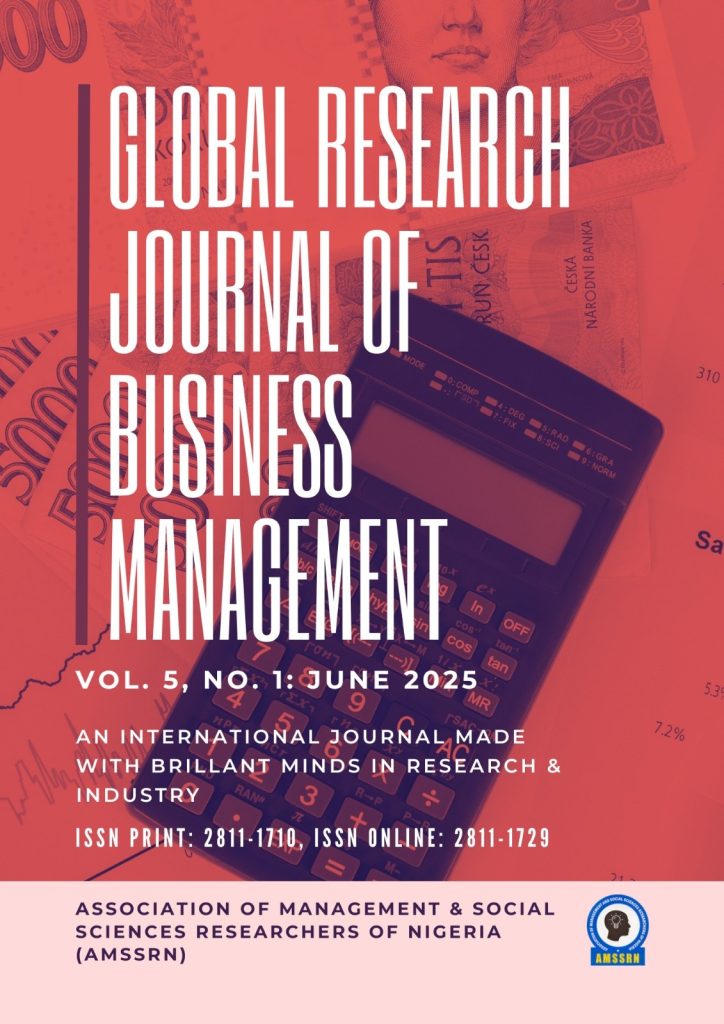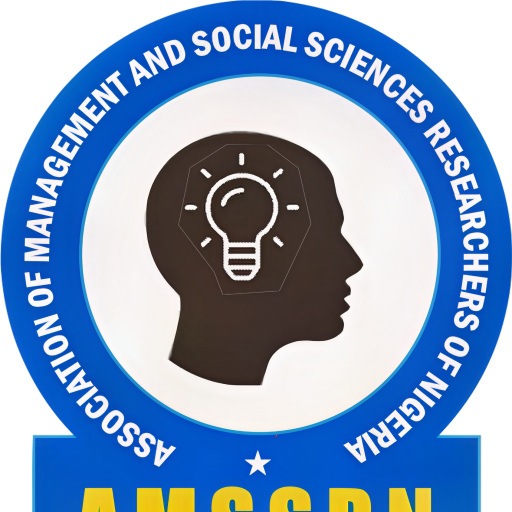
The cover of the 5th volume of the Global Research Journal of Business Management (GRJBM). All papers published in GRJBM can be found here.
Open Access link to the Global Research Journal of Business Management (GRJBM): https://journals.amssr.org/grjbm/
For Manuscript submission and General Enquires
| E-mail Address | [email protected] |
| Phone Number | +234 803 3366 045 |
Contact the Journal Editors
| Professor Yusufu A. Zoaka | Editor-in-Chief |
Aims & Scope
Global Research Journal of Business Management (GRJBM) advances both theoretical and empirical research, informs policies and practices, and improves understanding of how management and business decisions shape the lives of organizations, corporations, and the ripple effects at a macro-economic scale.
The journal is an open-access multidisciplinary journal and welcomes papers from all the major disciplines in business, administration & taxation. Great managers and policymakers are in constant search of performance-enhancing management practices. As a result, GRJBM places management and leadership at the center stage of business and organizational research in the World and the journal emphasizes an understanding of how theories and models support management practices. The journal also carries a section that stimulates practitioner-based dialogue offering its readers insights into how Foreign executives practice management.
Its target audience includes researchers, students, government officials, policymakers, and specialists who are concerned with business and management issues and their international effects.
Prepare your Submission
Before you submit your manuscript, it’s important you read and follow the guidelines below. You will also find some useful tips in our structure of your journal submission how-to guide.
| Format | Article files should be provided in Microsoft Word format. |
| Article length/word count | Articles should be between 3000 and 6000 words in length. This includes all text, for example, the structured abstract, references, all text in tables, and figures and appendices. Please allow 280 words for each figure or table. |
| Article title | A concisely worded title should be provided. |
| Author Details | The names of all contributing authors should be added to the email submission; please list them in the order in which you’d like them to be published. The following details should be included in the paper: Author email address (institutional preferred). Author name. We will reproduce it exactly, so any middle names and/or initials they want to be featured must be included. Author affiliation. This should be where they were based when the research for the paper was conducted. In multi-authored papers, it’s important that ALL authors that have made a significant contribution to the paper are listed. Those who have provided support but have not contributed to the research should be featured in an acknowledgments section. |
| Biographies and acknowledgments | If you want to include these items, save them in a separate Microsoft Word document and submit the file with your submission. Where they are included, a brief professional biography of not more than 100 words should be supplied for each named author. |
| Research funding | Your article must reference all sources of external research funding in the acknowledgments section. You should describe the role of the funder or financial sponsor in the entire research process, from study design to submission. |
| Structured abstract | All submissions must include a structured abstract, following the format outlined below. These four sub-headings and their accompanying explanations must always be included: Research Objectives, Methodology, Findings, Conclusion. The following three sub-headings are optional and can be included, if applicable: Research limitations, Recommendations, Practical/social implications. You can find some useful tips in our write an article abstract how-to guide. The maximum length of your abstract should be 250 words in total, including keywords and article classification (see the sections below). |
| Keywords | Your submission should include 5 or more appropriate and short keywords that capture the principal topics of the paper. Please note, while we will always try to use the keywords you’ve suggested, the in-house editorial team may replace some of them with matching terms to ensure consistency across publications and improve your article’s visibility. |
| Headings | Headings must be concise, with a clear indication of the required hierarchy. The preferred format is for first-level headings to be in bold, and subsequent sub-headings to be in medium italics. |
| Notes/endnotes | Notes or endnotes should only be used if absolutely necessary. They should be identified in the text by consecutive numbers enclosed in square brackets. These numbers should then be listed, and explained, at the end of the article. |
| Figures | All figures (charts, diagrams, line drawings, webpages/screenshots, and photographic images) should be submitted electronically. Both colour and black and white files are accepted. There are a few other important points to note: All figures should be supplied at the highest resolution/quality possible with numbers and text clearly legible. Acceptable formats are .ai, .eps, .jpeg, .bmp, and .tif. Electronic figures created in other applications should be supplied in their original formats and should also be copied and pasted into blank MS Word document or at its end (if to serve as an appendix). All figures should be numbered consecutively with Arabic numerals and have clear captions. All photographs should be numbered as Plate 1, 2, 3, etc., and have clear captions. |
| Tables | Give each table in the paper a brief title. Ensure that any superscripts or asterisks are shown next to the relevant items and have explanations displayed as footnotes to the table, figure or plate. |
| References | All references in your manuscript must be formatted using the APA 7th edition. |
Submit your manuscript
There are a number of key steps you should follow to ensure a smooth and trouble-free submission.
Double check your manuscript
Before submitting your work, it is your responsibility to check that the manuscript is complete, grammatically correct, and without spelling or typographical errors. A few other important points:
- Give the journal aims and scope a final read. Is your manuscript definitely a good fit? If it isn’t, the editor may decline it without peer review.
- Does your manuscript comply with research and publishing ethics guidelines (including no plagiarism)?
- Have you cleared any necessary publishing permissions?
- Have you followed all the formatting requirements laid out in these author guidelines?
- Does the manuscript contain any information that might help the reviewer identify you? This could compromise the blind peer review process. A few tips:
- If you need to refer to your own work, use wording such as ‘previous research has demonstrated’ not ‘our previous research has demonstrated’.
- If you need to refer to your own, currently unpublished work, don’t include this work in the reference list.
- Any acknowledgments or author biographies should be uploaded as separate files.
- Carry out a final check to ensure that no author names appear anywhere in the manuscript. This includes in figures or captions.
Peer Review and decision process
Each submission is checked by the editor and goes through a rigorous blind peer review process. At this stage, they may choose to ask you to make changes or decline your manuscript if it doesn’t fit the journal’s aims and scope, or they feel the language/manuscript quality is too low. The goal is that the editor will inform you of their first decision within 14 days.
During this period, we may call or send you automated updates on the progress of your manuscript via email.
Frequently asked questions
| How can I become a reviewer for a journal? | Please contact the editorial team through the contact details above, with a copy of your CV. |
| Who do I contact if I want to find out which volume and issue my accepted paper will appear in? | Typically, papers are added to an issue according to their date of publication. If you would like to know in advance which issue your paper will appear in, please contact the editorial team through the contact details above. |
| Who do I contact if I have a query about my submission? | Please email the editorial team through the contact details above. |
| Is my paper suitable for the journal? | If you’ve read the aims and scope on the journal landing page and are still unsure whether your paper is suitable for the journal, please call/email the editorial team through the contact details above. |
| How do I make a change to the list of authors once the manuscript has been submitted? | Authorship and the order in which the authors are listed on the paper should be agreed upon prior to submission. If you need to make any changes to the author information once the paper is under review or has been accepted, we will look into your request and closely follow authorship guidelines. |
Thank you and great success publishing with us.
